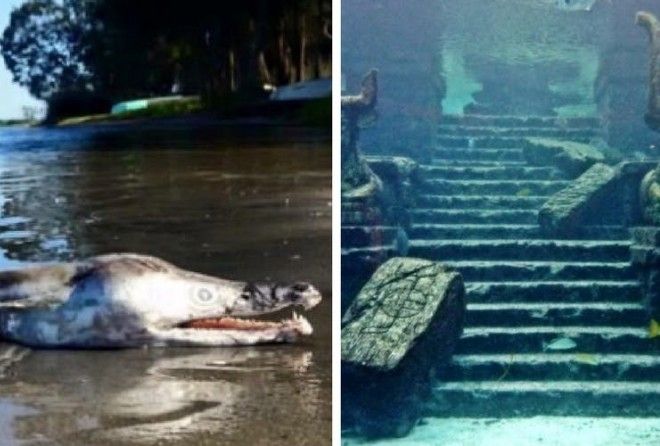The more we explore, in fact, the less we seem to know about much of what goes on in the deep waters of the world’s oceans. We discover creatures and phenomena we can’t explain. Ships and planes go missing and are never found. Sounds and vibrations are heard, but no one knows where they come from.
In some ways, the deep water environment and its denizens are about as alien to our above ground world as we are to outer space. With technology only recently reaching the point where deep-sea explorations can occur on a routine basis, the answers to many questions may be on the way. But, with so much left to discover, who knows how many new mysteries will be found?
15. Submarine Mystery
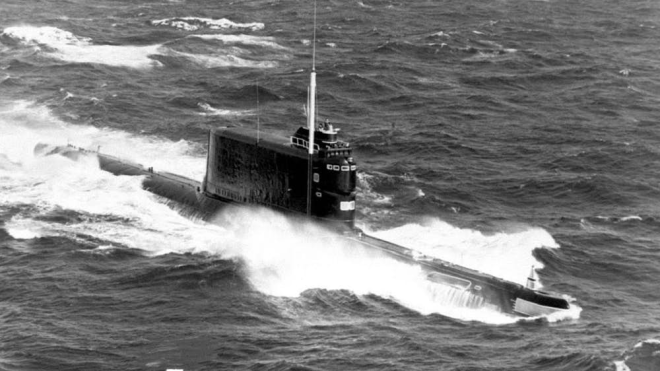
It’s been five decades, and there is still no scientific explanation for why four submarines belonging to four different countries all disappeared under mysterious circumstances back in 1968. The American USS Scorpion, Israeli INS Darak, French Minerve, and Soviet K-129 all went missing with no adequate explanation that would cover all four, although there have been plenty of theories from misfiring nuclear missiles and Soviet-US aggression to nefarious government cover-ups. The Dakar and Minerve disappeared two days apart in the Mediterranean. The Dakar was found on the seafloor near Cyprus about 31 years after the fact, and part of the K-129 was recovered 3 miles below the surface of the ocean in 1974. The loss of the Minerve was especially puzzling, because it happened a mere 25 miles away from its home port.
14. The Mystery Of The Cannibal Shark

In 2003, Australian researchers tagged a 9-foot-long female great white shark to track its movements. The tag recorded temperatures and depth and was attached in November 2003 off the southwestern coast. About four months later, the tag was found on land by a beachcomber about 2.5 miles from where it had been first attached to the shark. Data from the tag was so out of the ordinary that a film maker who had been hired to make a documentary out of the data couldn’t quite believe what he saw. As the tag recorded it, the animal suddenly plunged down 1,903 feet and the temperature spiked from 46°F to 78°F. The data suggested an attack — but what could (or would) attack a 9-foot shark? An even bigger shark? Cannibalism is one of the theories that has never been proven in this case, with one researcher speculating on a “two-ton colossal cannibal great white shark.” Yikes!
13. Japanese Atlantis

The lost city of Atlantis is the stuff of legends. In Greek mythology, it was swallowed up by the ocean after falling out of favor with the gods. But, could the ancients have gotten it wrong — was Atlantis really located off the coast of Japan? In 1986, a diver near Yonaguni Jima, an island south of the Japanese mainland, found a series of underwater structures covering a large area. Masaaki Kimura, a marine geologist at the University of Ryukyus, believes the structures resemble castle ruins, temples, and a stadium, among other buildings. Other experts disagree, noting that sandstone does have a tendency to break down into planes with straight edges that can look like buildings. Are they the ruins of a city buried by a long ago earthquake? The so-called Yonaguni Monument or Yonaguni Submarine Ruins remain a mystery. While some private expeditions and many amateur divers have explored the area, the Japanese government refuses to recognize the formations as ruins and has not investigated the claims.
12. The Milky Sea

Sailors from centuries past were full of wild tales of mermaids and sea serpents, so maybe it’s not so surprising that those old stories about encountering waters that were pale and glowing, with a milky kind of color weren’t believed. At least, not until 1995, when a British ship encountered seas that were described as milky white. What was at play? Scientists eventually determined that the glow was due to luminous bacteria — or bioluminescent dinoflagellates for the science nerds. But pinpointing the cause doesn’t clear up the mystery. The bacteria glow for a number of reasons, including avoiding predators and courtship. But, why do the bacteria come together in the trillions, but only at certain times and locations? Why does it seem to be caused by disturbances in the water at night? As one professor put it, the discovery of the bacteria leaves researchers with more questions than it answers.
11. Baltic Sea Anomaly

Back in June 2011, Swedish explorer Peter Lindberg and his team of marine explorers he called Ocean X discovered a strange formation at the bottom of the Baltic Sea. It is 210 feet long, 26 feet high, and it lies 300 feet below the surface. With its steel gray appearance and what look like oddly carved patterns, many have pointed out that it looks like a UFO — even the Millennium Falcon. Other observers think it could be the remains of a lost city. Researchers at the Stockholm University in Sweden have tried to dampen the speculation by insisting the Anomaly is simply an unusual carving made by the movement of glaciers during the last Ice Age. However, many remain unconvinced, including the crew of the Ocean X, who insist that all their electrical equipment, including satellite phones, stopped working whenever they got within about 160 feet of the object.
10. Black Smokers – The Origin Of Life?

Black smokers are the name coined by scientists to describe holes in the floor of the ocean where super-heated water spews up from the Earth below the sea floor. Scientists probing the waters within the Arctic Circle have recently discovered a series of black smokers or hydrothermal vents 120 miles farther north than they’d ever been observed before. The formation has been dubbed “Loki’s Castle.” The water that spills out of these vents into the cooler ocean waters can reach as hot as 570°F. The vents occur where the tectonic plates that make up the ocean floor move apart at different rates, and the water that pours out is rich in minerals as well as hot. The Arctic vents reach up as far as four stories from the seafloor and these so-called chimneys are covered with white bacteria that love the minerals in the hot water. In fossilized form, primitive forms of bacteria have been found on vents that date back about 1.43 billion years. It has led to the question — are these hydrothermal vents the places where life first began on planet Earth?
9. Immortal Jellyfish

Does a jellyfish with the scientific name of Turritopsis dohrnii hold the key to immortality? First discovered in the Mediterranean in 1883, most Turritopsis are born and die the usual way. But, when they’re subjected to extreme stress, such as starvation or serious injury, the jellyfish has the ability to reverse its aging process and revert to a baby. And what’s more, it can do it over and over again under the right circumstances. Sounds like a very useful skill, but the creature that has been dubbed the Benjamin Button jellyfish is taking over the world’s oceans, pushing competing animals out of the way. The jellyfish’s cells can be completely transformed, and when they transform themselves back into what is essentially a jellyfish prototype, they can spawn hundreds of perfect copies of the original fish. How do they do it? Wish we knew!
8. Cephalopods

Octopuses are the most complex animal on earth with the most distant branch of DNA from that of human beings. They’re super intelligent, and we’ve all seen those Youtube videos of them sneaking out of a boat via a pinhole or something close to it. Cephalopods – the class of animal that includes squid and octopuses – are among the most mysterious of all the creatures that live in the depths of the ocean. They live so far down that we know very little about them, and what we do learn makes them even more mysterious. The Megaleledone setebos or giant Antarctic octopus drills holes into mollusk shells and then injects its poisonous saliva. The giant squid (pictured above) was first filmed in July 2012, reaching about 43 feet long and weighing up to 1,000 pounds. The colossal squid can dive 6,5000 feet down below the surface of the water. It is so massive that its eyes alone measure 11 inches across. That’s based on a 26-foot animal caught in the Ross Sea. Then there’s the vampire squid, which glows red through the tips of its tentacles and spots along its side. The recently discovered bigfin squid can reach 16 feet long and looks something like a boat’s rudder.
7. Photosynthesis Far From The Sun

Most of us learned something about photosynthesis in school at some point. It’s the process where plants make food for themselves out of sunlight, producing oxygen for us to breathe while they’re at it. So how do plants manage to photosynthesize way down in the depths of the ocean? In 2005, a research team found bacteria that was surviving via photosynthesis 7,875 feet below the surface. The hardy bacteria had taken hold near hydrothermal vents off the coast of Mexico, living in a very limited range between vent where 662°F water was spewing out and the nearly freezing water that surrounded it. The tiny organisms were photosynthesizing using the very dim light that was created by the heated water. Just how that occurs is still a mystery to scientists.
6. Mysterious Sounds From The Deep Advertising
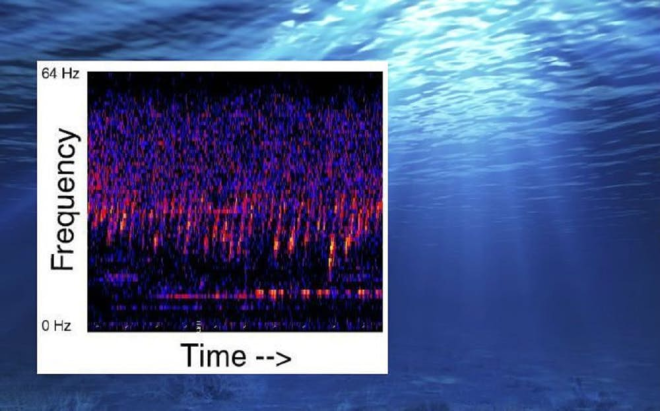
The National Oceanic and Atmospheric Administration (NOAA) monitors sounds in the oceans, some of which can’t be explained. One, called upsweep, has been heard since 1991. Upsweep describes the type of sound wave, and it has been detected across the Pacific Ocean. The source is unknown, but it has been decreasing over time from 1991 till today. Even though it has diminished, it can still be detected, usually in spring and autumn. There was the Julia incident. The NOAA detected a sound that sounded eerily like the name Julia over a 15-second time period in 1999. Experts theorize that the unusual sound arose from the ricochet of an iceberg in the Antarctic, which then echoed near the equator. Then there is the sound known as the Bloop, a loud, ultra-low frequency sound detected in 1997. What made it so unusual was that it was heard at listening stations over 3,000 miles apart across the Pacific. There was speculation of a giant sea creature, but most scientists now believe it to be an icequake, or break up of a large iceberg. But, no one is sure.
5. Underwater Lakes Of Molten Sulfur
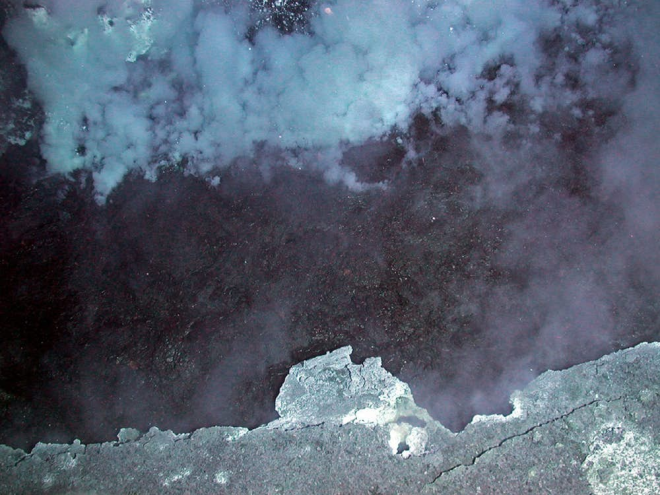
Until recently, it was believed that lakes of molten sulfur only existed in outer space, in places like the moons of Jupiter. The Daikoku Sulfur Cauldron is located on the Pacific Ring of Fire, an area between the Northern Mariana Islands and Bonin Islands where there is a lot of volcanic activity on the ocean floor. The area was under study by NOAA scientists in 2006, using a robot sub to explore one of the volcanoes. About 1300 feet below the surface, the robot, dubbed Jason, detected a black spot on one of the volcano’s craters. As they dropped an anchor into the spot, they discovered that it was a lake of liquid sulfur covered by a black, rubbery crust that billows with hydrogen and other gases. The area is home to strange species of fish and other life forms that feed off the liquid sulfur. It is unknown whether this phenomenon will last, or for how long. It was the second such discovery, a smaller one having been found near Japan in November 2005.
4. Megalodon

Megalodon means “big tooth” in Latin. It refers to a species of giant shark that scientists believe lived from about 23 million years ago until about 2.6 million years ago. But, did the monster giant shark really become extinct, or is it still lurking out there in the deep, deep waters of the ocean? Every now and then, evidence emerges purporting to show one of these monsters, like a recent video that showed Japanese scientists recording what turned out to be a huge sleeper shark in Suruga Bay. The idea isn’t as far fetched as it might sound. After all, scientists only saw their first Megamouth Shark, which lives in deep water, in 1976. And, there’s the Coelacanth, a fish that was thought to be extinct for 65 million years, only to be found off the coast of South Africa in 1938. A series of sightings and findings continue to fuel speculation about the Megalodon. Two Magalodon teeth were found in 1875. In 1918, fishermen in Australia were terrorized by a white shark they claimed was more than 100 feet long. In the 1960s, the captain of a 55-foot ship claimed that a shark as long as the boat had passed by them, and in 2012, on an episode of a show called Shark Wranglers, South African fishermen described a 30- to 40-foot shark they had seen near a place called Bird Island. Is it out there or not? We’ll let the experts find the proof!
3. Leptocephalus Giganteus – The Sea Serpent
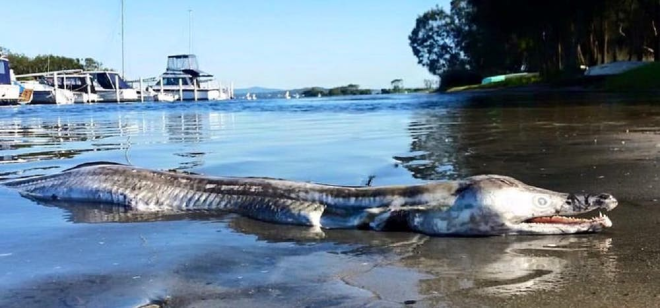
Could those ancient stories about sea serpents really have been true? If they were, scientists say they are actually giant eels. On January 31, 1930, a Danish research ship called the Dana captured an eel larva which measured over 6 feet long off the coast of South Africa. It’s significant because the 3-inch larva of a common eel grows into a 4-foot beast. That would make the adult version of a 6-foot larva, captured about 1,000 feet below the surface, about 72 feet long. Unfortunately, the specimen was washed overboard. Another larva measuring about 3 feet long was found off the coast of New Zealand in 1959 and described by Peter Henry John Castle, an eel expert. The world is still waiting to meet an adult version.
2. Bermuda Triangle
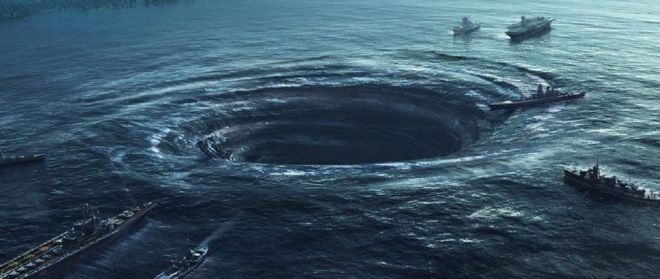
The Bermuda Triangle is one of the ocean’s most enduring and well known mysteries. Since 1918, 75 planes and hundreds of ships have gone missing over the region in the North Atlantic that lies roughly between Miami, Bermuda and Puerto Rico, and is also called the Devil’s Triangle. In 19188, the USS Cyclops vanished there, along with a crew of about 300. In 1945, the compasses on five Navy bombers stopped working and the planes were lost. A rescue plane that was sent to find them also disappeared. Even Christopher Columbus noted strange lights and flames that crashed into the sea in the area. About four planes and 20 yachts go missing in the area each year. There are many theories about what goes on in that seemingly cursed region of the ocean, including decomposing gases which create sinkholes in the waters, and hexagonal storm clouds that create violent blasts of wind. After a century, the mystery endures.
1. Cuba’s Underwater City

In 2000, a joint Cuban-Canadian expedition discovered what they are calling an underwater city about 2,300 feet below the waves near the coast of Cuba. A find at that depth is strange, since the sea levels have not fallen below about 400 feet below sea level since humans have walked the earth. A city that far down could have been pushed deep by the movement of tectonic plates – it’s a theory that has been posited. Near Cabo de San Antonio, researchers found smooth blocks and geometric shapes on the ocean floor and took sonar images (pictured above.) The find has interested scientists at Cuba’s Natural History Museum. In the Museum’s report, the institution notes that the find does coincide with some of the ancient traditions of the Maya and Yucatecos people who tell stories about an island that sank beneath the ocean. Research at the site is still ongoing.
